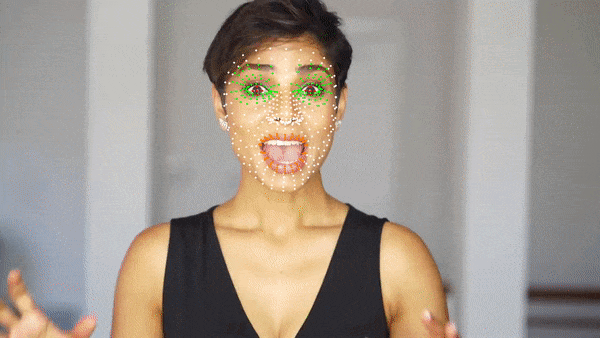Running Google Mediapipe Face Mesh and Hand Tracking models on Luxonis DepthAI hardware (OAK-D, OAK-D lite, OAK-1,...). The hand tracking is optionnal and can be disabled by setting the argument nb_hands to 0.
WIP
The models used in this repository are:
- Mediapipe Blazeface, the short range version, for face detection. The distance face-camera must be < 2m.
- Mediapipe Face Mesh for face landmark detection(468 landmarks). I call this model the basic model in this document,
- Mediapipe Face Mesh with attention. This is an alternative to the previous model. In addition to the 468 landmarks, it can detect 10 more landmarks corresponding to the irises. Its predictions are more accurate around lips and eyes, at the expense of more compute (FPS on OAK-D ~10 frames/s). I call this model the attention model.
- The Mediapipe Palm Detection model (version 0.8.0) and Mediapipe Hand Landmarks models (version lite), already used in depthai_hand_tracker.
Note that, whenever possible, the post-processing of the models output has been integrated/concatenated to the models themselves, thanks to PINTO's simple-onnx-processing-tools. Thus, Non Maximum Suppression for the face detection and palm detection models as well as some calculation with the 468 or 478 face landmarks are done at the level of the models. The alternative would have been to do these calculations on the host or in a script node on the device (slower).
Install the python packages (depthai, opencv) with the following command:
python3 -m pip install -r requirements.txt
Usage:
->./demo.py -h
usage: demo.py [-h] [-i INPUT] [-a] [-2] [-n {0,1,2}] [-xyz] [-f INTERNAL_FPS]
[--internal_frame_height INTERNAL_FRAME_HEIGHT] [-t [TRACE]]
[-o OUTPUT]
optional arguments:
-h, --help show this help message and exit
Tracker arguments:
-i INPUT, --input INPUT
Path to video or image file to use as input (if not
specified, use OAK color camera)
-a, --with_attention Use face landmark with attention model
-2, --double_face EXPERIMENTAL. Run a 2nd occurence of the face landmark Neural Network
to improve fps. Hand tracking is disabled.
-n {0,1,2}, --nb_hands {0,1,2}
Number of hands tracked (default=2)
-xyz, --xyz Enable spatial location measure of palm centers
-f INTERNAL_FPS, --internal_fps INTERNAL_FPS
Fps of internal color camera. Too high value lower NN
fps (default= depends on the model)
--internal_frame_height INTERNAL_FRAME_HEIGHT
Internal color camera frame height in pixels
-t [TRACE], --trace [TRACE]
Print some debug infos. The type of info depends on
the optional argument.
Renderer arguments:
-o OUTPUT, --output OUTPUT
Path to output video file
Some examples:
-
To run the basic face model with 2 hands max tracking:
./demo.py -
Same as above but with the attention face model:
./demo.py -a -
To run only the Face Mesh model (no hand tracking):
./demo.py [-a] -n 0 -
If you want to track only one hand (instead of 2), you will get better FPS by running:
./demo.py [-a] -n 1 -
Instead of the OAK* color camera, you can use another source (video or image) :
./demo.py [-a] -i filename -
To measure face and hand spatial location in camera coordinate system:
./demo.py [-a] -xyzThe measure is made on the wrist keypoints and on a point of the forehead between the eyes.
| Keypress | Function |
|---|---|
| Esc | Exit |
| space | Pause |
| 1 | Show/hide the rotated bounding box around the hand |
| 2 | Show/hide the hand landmarks |
| 3 | Show/hide the rotated bounding box around the face |
| 4 | Show/hide the face landmarks |
| 5 | Show/hide hand spatial location (-xyz) |
| 6 | Show/hide the zone used to measure the spatial location (small purple square) (-xyz) |
| f | Switch between several face landmark rendering |
| f | Switch between several hand landmark rendering |
| b | Draw the landmarks on a black background |
- Google Mediapipe
- Katsuya Hyodo a.k.a Pinto, the Wizard of Model Conversion !
- The video used in the illustration is 6 Eye Exercises: Tighten Droopy Eyelids and Reduce Wrinkles Around Eyes/ Blushwithme-Parmita
